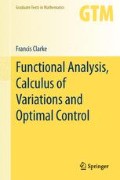Abstract
A normed space X is said to be a Banach space if its metric topology is complete. This means that every Cauchy sequence x i in X admits a limit in X: there exists a point x∈ X such that ∥ x i −x ∥→ 0. Informally, the reader may understand the absence of such a point x as meaning that the space has a hole where x should be. For purposes of minimization, one of our principal themes, it is clear that the existence of minimizers is imperiled by such voids. The existence of solutions to minimization problems is not the only compelling reason, however, to require the completeness of a normed space, as we shall see. The property is essential in making available to us certain basic tools developed in this chapter, such as uniform boundedness, minimization principles, and weak compactness.
Access this chapter
Tax calculation will be finalised at checkout
Purchases are for personal use only
Notes
- 1.
This in contrast to the purely metric case, in which completeness depends on the choice of metric, even among those inducing the same topology.
- 2.
See for example Royden [36].
- 3.
We have in mind: Theorem. Let (E,d) be a complete metric space, and F n a sequence of closed subsets of E such that int { ⋃ n F n } ≠ ∅. Then there exists N such that int F N ≠ ∅.
- 4.
The other two are: every convergent sequence of functions is nearly uniformly convergent, and every measurable set is nearly a finite union of intervals.
- 5.
Prop. 4.6 established the nonemptiness of the subdifferential at points of continuity.
References
H. L. Royden. Real Analysis. Macmillan, London, 1968.
Author information
Authors and Affiliations
Rights and permissions
Copyright information
© 2013 Springer-Verlag London
About this chapter
Cite this chapter
Clarke, F. (2013). Banach spaces. In: Functional Analysis, Calculus of Variations and Optimal Control. Graduate Texts in Mathematics, vol 264. Springer, London. https://doi.org/10.1007/978-1-4471-4820-3_5
Download citation
DOI: https://doi.org/10.1007/978-1-4471-4820-3_5
Published:
Publisher Name: Springer, London
Print ISBN: 978-1-4471-4819-7
Online ISBN: 978-1-4471-4820-3
eBook Packages: Mathematics and StatisticsMathematics and Statistics (R0)

